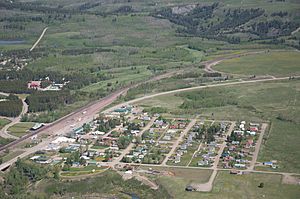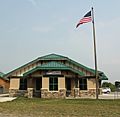East Glacier Park Village, Montana facts for kids
Quick facts for kids
East Glacier Park, Montana
|
|
|---|---|
 |
|

Location of East Glacier Park, Montana
|
|
| Country | United States |
| State | Montana |
| County | Glacier |
| Area | |
| • Total | 4.36 sq mi (11.29 km2) |
| • Land | 4.36 sq mi (11.29 km2) |
| • Water | 0.00 sq mi (0.00 km2) |
| Elevation | 4,823 ft (1,470 m) |
| Population
(2020)
|
|
| • Total | 354 |
| • Density | 81.21/sq mi (31.36/km2) |
| Time zone | UTC−7 (Mountain (MST)) |
| • Summer (DST) | UTC−6 (MDT) |
| Area code(s) | 406 |
| FIPS code | 30-22985 |
| GNIS feature ID | 1867336 |
East Glacier Park is a small community in Montana, United States. It is known as a "census-designated place" (CDP). This means it's a special area that the government counts for population, even though it's not a city or town. The Blackfeet people call it Omahkoyis, which means "Big Tree Lodge." In 2020, about 354 people lived here.
Contents
A Look Back: East Glacier Park's History
East Glacier Park started as a railway community. The Great Northern Railway planned the area in the 1890s. It was first called Midvale. Later, its name changed to Glacier Park. In 1949, it officially became East Glacier Park.
You can find two places here listed on the National Register of Historic Places. This is a list of important historical sites in the U.S. These are the Ranger Station Historic District and the Women's Club.
Exploring East Glacier Park's Geography
East Glacier Park covers about 4.4 square miles (11.29 square kilometers) of land. There are many lakes in the area. This community is located in Glacier County.
East Glacier Park's Climate
The climate in East Glacier Park is a mix of subarctic and humid continental. Summers are warm and pleasant. Winters usually start in November and last until March. It gets very cold and receives over 176 inches of snow each year.
| Climate data for East Glacier, Montana, 1991–2020 normals, 1971-2020 extremes: 4806ft (1465m) | |||||||||||||
|---|---|---|---|---|---|---|---|---|---|---|---|---|---|
| Month | Jan | Feb | Mar | Apr | May | Jun | Jul | Aug | Sep | Oct | Nov | Dec | Year |
| Record high °F (°C) | 57 (14) |
63 (17) |
67 (19) |
80 (27) |
86 (30) |
89 (32) |
97 (36) |
97 (36) |
92 (33) |
86 (30) |
67 (19) |
55 (13) |
97 (36) |
| Mean maximum °F (°C) | 48.3 (9.1) |
49.1 (9.5) |
55.0 (12.8) |
65.4 (18.6) |
74.5 (23.6) |
81.1 (27.3) |
87.2 (30.7) |
87.6 (30.9) |
82.7 (28.2) |
70.7 (21.5) |
— | 47.3 (8.5) |
89.5 (31.9) |
| Mean daily maximum °F (°C) | 30.4 (−0.9) |
30.5 (−0.8) |
37.1 (2.8) |
45.6 (7.6) |
55.6 (13.1) |
64.1 (17.8) |
73.8 (23.2) |
74.0 (23.3) |
63.3 (17.4) |
49.9 (9.9) |
36.3 (2.4) |
29.3 (−1.5) |
49.2 (9.5) |
| Daily mean °F (°C) | 21.7 (−5.7) |
21.8 (−5.7) |
28.0 (−2.2) |
36.1 (2.3) |
44.9 (7.2) |
52.7 (11.5) |
59.9 (15.5) |
59.2 (15.1) |
50.5 (10.3) |
39.6 (4.2) |
29.0 (−1.7) |
21.9 (−5.6) |
38.8 (3.8) |
| Mean daily minimum °F (°C) | 13.1 (−10.5) |
13.0 (−10.6) |
18.9 (−7.3) |
26.5 (−3.1) |
34.3 (1.3) |
41.3 (5.2) |
46.0 (7.8) |
44.4 (6.9) |
37.7 (3.2) |
29.4 (−1.4) |
21.8 (−5.7) |
14.6 (−9.7) |
28.4 (−2.0) |
| Mean minimum °F (°C) | −17.2 (−27.3) |
−12.8 (−24.9) |
−6.5 (−21.4) |
9.0 (−12.8) |
23.0 (−5.0) |
31.3 (−0.4) |
36.6 (2.6) |
33.6 (0.9) |
25.8 (−3.4) |
9.8 (−12.3) |
−4.6 (−20.3) |
−13.4 (−25.2) |
−27.9 (−33.3) |
| Record low °F (°C) | −36 (−38) |
−44 (−42) |
−35 (−37) |
−13 (−25) |
16 (−9) |
15 (−9) |
30 (−1) |
18 (−8) |
8 (−13) |
−14 (−26) |
−26 (−32) |
−42 (−41) |
−44 (−42) |
| Average precipitation inches (mm) | 3.09 (78) |
2.56 (65) |
2.55 (65) |
2.21 (56) |
2.89 (73) |
4.00 (102) |
1.54 (39) |
1.46 (37) |
2.17 (55) |
2.55 (65) |
2.78 (71) |
2.63 (67) |
30.43 (773) |
| Average snowfall inches (cm) | 29.4 (75) |
26.8 (68) |
23.9 (61) |
15.7 (40) |
4.0 (10) |
1.4 (3.6) |
0.0 (0.0) |
0.4 (1.0) |
2.1 (5.3) |
9.9 (25) |
21.2 (54) |
29.9 (76) |
164.7 (418.9) |
| Average extreme snow depth inches (cm) | 26.1 (66) |
30.4 (77) |
30.7 (78) |
22.7 (58) |
7.2 (18) |
0.8 (2.0) |
0.0 (0.0) |
0.3 (0.76) |
1.3 (3.3) |
7.8 (20) |
11.2 (28) |
18.5 (47) |
37.4 (95) |
| Source 1: NOAA | |||||||||||||
| Source 2: XMACIS2 (records, monthly max/mins & snowfall/depth) | |||||||||||||
| Climate data for East Glacier, snowfall 1949-present | |||||||||||||
|---|---|---|---|---|---|---|---|---|---|---|---|---|---|
| Month | Jan | Feb | Mar | Apr | May | Jun | Jul | Aug | Sep | Oct | Nov | Dec | Year |
| Record high °F (°C) | 57 (14) |
63 (17) |
67 (19) |
80 (27) |
86 (30) |
89 (32) |
97 (36) |
97 (36) |
92 (33) |
86 (30) |
67 (19) |
53 (12) |
97 (36) |
| Mean daily maximum °F (°C) | 32.6 (0.3) |
34.5 (1.4) |
40.8 (4.9) |
48.8 (9.3) |
58.2 (14.6) |
66.8 (19.3) |
74.9 (23.8) |
74.7 (23.7) |
63.7 (17.6) |
53.1 (11.7) |
38.0 (3.3) |
31.1 (−0.5) |
51.4 (10.8) |
| Mean daily minimum °F (°C) | 12.8 (−10.7) |
13.6 (−10.2) |
19.4 (−7.0) |
27.1 (−2.7) |
34.3 (1.3) |
40.7 (4.8) |
45.3 (7.4) |
44.0 (6.7) |
37.4 (3.0) |
29.5 (−1.4) |
21.4 (−5.9) |
13.4 (−10.3) |
28.2 (−2.1) |
| Record low °F (°C) | −36 (−38) |
−44 (−42) |
−35 (−37) |
−13 (−25) |
16 (−9) |
15 (−9) |
30 (−1) |
18 (−8) |
8 (−13) |
−12 (−24) |
−26 (−32) |
−42 (−41) |
−44 (−42) |
| Average precipitation inches (mm) | 2.43 (62) |
1.90 (48) |
1.89 (48) |
1.67 (42) |
2.34 (59) |
3.30 (84) |
1.74 (44) |
1.33 (34) |
1.76 (45) |
1.74 (44) |
2.60 (66) |
2.44 (62) |
25.14 (638) |
| Average snowfall inches (cm) | 34.4 (87) |
26.5 (67) |
25.1 (64) |
18.9 (48) |
4.1 (10) |
1.0 (2.5) |
0.0 (0.0) |
0.2 (0.51) |
2.3 (5.8) |
8.3 (21) |
24.5 (62) |
31.1 (79) |
176.4 (446.81) |
| Average precipitation days | 14 | 11 | 13 | 10 | 10 | 11 | 8 | 8 | 8 | 9 | 11 | 13 | 126 |
| Average snowy days | 12 | 8 | 9 | 6 | 2 | 0.2 | 0 | 0.1 | 1 | 3 | 8 | 10 | 59.3 |
Who Lives in East Glacier Park?
| Historical population | |||
|---|---|---|---|
| Census | Pop. | %± | |
| 2020 | 354 | — | |
| U.S. Decennial Census | |||
In 2000, there were 396 people living in East Glacier Park. They lived in 148 households. About half of the people were White and about half were Native American. A small number of people were from other backgrounds.
About 35% of households had children under 18. The average household had about 2.68 people. The average family had about 3.27 people. The median age in the community was 36 years old.
Getting Around and Staying Safe
Transportation Options
The East Glacier Park Amtrak Station is a train stop. It is open during spring, summer, and fall. The Empire Builder train stops here. This train travels between Chicago and Seattle/Portland. In winter, the train stops at Browning, Montana, which is nearby. The closest airport is Glacier Park International Airport in Kalispell.
Emergency Services
The East Glacier Volunteer Fire Department started in 1968. Today, about 18 volunteers work there. They help protect the community from wildfires and other emergencies.
Images for kids
See also
 In Spanish: East Glacier Park Village (Montana) para niños
In Spanish: East Glacier Park Village (Montana) para niños




